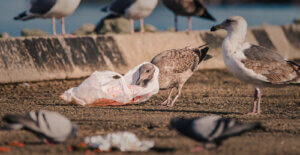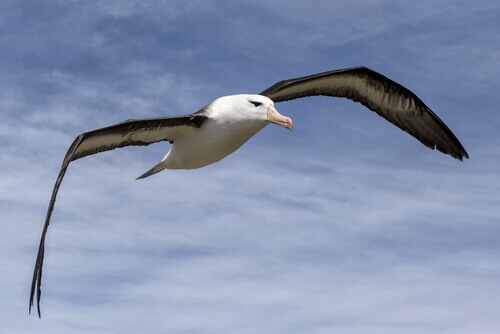The Effects of Climate Change and Plastic Pollution on Seabirds


Written and verified by the vet Eugenio Fernández Suárez
Climate change threatens all living beings on the planet, including human beings. Unfortunately, the effects of climate change and pollution on animals such as seabirds are even more obvious.
Climate change and seabirds
Recent studies reveal that many seabirds aren’t able to adapt their reproductive cycle to the climate changes that are occurring. Other species have been able to adapt, such as the prey of these birds.
In contrast, scientists believe that seabirds won’t be able to adapt to the changes that are coming to their ecosystems. Usually the period in which the eggs hatch coincides with a time when there’s an abundance of prey, but the new climate panorama hasn’t changed the habits of these birds. This means they’re now raising their chicks when food is scarce.
Seabirds are the most threatened birds on the planet, and the low number of offspring they have over their long lives makes them even more likely to be affected by environmental changes. This has resulted in numerous species in their ranks becoming endangered.
Seabirds and plastic
However, this isn’t the only problem these birds face; seabirds are also one of the animal groups most threatened by marine pollution from plastics and other human waste.
These birds have the misfortune of confusing bottle caps and other plastic trash with food. This causes them to die in large numbers, with their crops and the rest of their digestive systems full of plastic.
The data gathered by the scientific community is worrying. They estimate that, by 2050, 99% of seabirds will have plastic lodged in their digestive systems. This data contrasts with figures from 1960, when plastic was only present in 5% of necropsies performed.
This ingestion has some terrible effects. In addition to the possible toxicity, the birds can suffer from obstructions in their intestines, which can lead to weight loss and death. In some marine birds, people have found up to 200 pieces of plastic per specimen. This has obviously put the international scientific community on alert; it’s estimated that plastics in the oceans kill 1.5 million animals per year.
The albatross, one of the most affected seabirds
Of all the seabirds that have to deal with plastic pollution and climate change, the albatross is one of the most affected. This family of monogamous birds are large and have long biological cycles and long migrations, which makes them less adaptable.
In addition, their diet is based on krill, fish, and squid, all of which are affected by plastic pollution. So, the albatross doesn’t only confuse plastic with food, but the food it eats also contains plastic.
These birds give us an idea of how human activities affect distant ecosystems. Albatrosses live in colonies, and they nest in remote and isolated areas, far from human activity. Even so, plastic ends up in their stomachs, in places where we might expect hardly any pollution.
Plastic production has increased exponentially in recent years: although useful, plastic is very polluting and doesn’t biodegrade easily. And the worst thing is that we’re seeing that recycling hasn’t yet taken hold in many populations and, even where it has, it’s still woefully inefficient.
This has made more and more environmentalists, scientists, and animal protectors warn us about the future of plastic. Many are clear that recycling isn’t the solution; we must opt for cardboard, glass, or cloth containers and abandon plastic packaging. A bag from your local supermarket may just end up in the stomach of a loggerhead turtle.
Climate change threatens all living beings on the planet, including human beings. Unfortunately, the effects of climate change and pollution on animals such as seabirds are even more obvious.
Climate change and seabirds
Recent studies reveal that many seabirds aren’t able to adapt their reproductive cycle to the climate changes that are occurring. Other species have been able to adapt, such as the prey of these birds.
In contrast, scientists believe that seabirds won’t be able to adapt to the changes that are coming to their ecosystems. Usually the period in which the eggs hatch coincides with a time when there’s an abundance of prey, but the new climate panorama hasn’t changed the habits of these birds. This means they’re now raising their chicks when food is scarce.
Seabirds are the most threatened birds on the planet, and the low number of offspring they have over their long lives makes them even more likely to be affected by environmental changes. This has resulted in numerous species in their ranks becoming endangered.
Seabirds and plastic
However, this isn’t the only problem these birds face; seabirds are also one of the animal groups most threatened by marine pollution from plastics and other human waste.
These birds have the misfortune of confusing bottle caps and other plastic trash with food. This causes them to die in large numbers, with their crops and the rest of their digestive systems full of plastic.
The data gathered by the scientific community is worrying. They estimate that, by 2050, 99% of seabirds will have plastic lodged in their digestive systems. This data contrasts with figures from 1960, when plastic was only present in 5% of necropsies performed.
This ingestion has some terrible effects. In addition to the possible toxicity, the birds can suffer from obstructions in their intestines, which can lead to weight loss and death. In some marine birds, people have found up to 200 pieces of plastic per specimen. This has obviously put the international scientific community on alert; it’s estimated that plastics in the oceans kill 1.5 million animals per year.
The albatross, one of the most affected seabirds
Of all the seabirds that have to deal with plastic pollution and climate change, the albatross is one of the most affected. This family of monogamous birds are large and have long biological cycles and long migrations, which makes them less adaptable.
In addition, their diet is based on krill, fish, and squid, all of which are affected by plastic pollution. So, the albatross doesn’t only confuse plastic with food, but the food it eats also contains plastic.
These birds give us an idea of how human activities affect distant ecosystems. Albatrosses live in colonies, and they nest in remote and isolated areas, far from human activity. Even so, plastic ends up in their stomachs, in places where we might expect hardly any pollution.
Plastic production has increased exponentially in recent years: although useful, plastic is very polluting and doesn’t biodegrade easily. And the worst thing is that we’re seeing that recycling hasn’t yet taken hold in many populations and, even where it has, it’s still woefully inefficient.
This has made more and more environmentalists, scientists, and animal protectors warn us about the future of plastic. Many are clear that recycling isn’t the solution; we must opt for cardboard, glass, or cloth containers and abandon plastic packaging. A bag from your local supermarket may just end up in the stomach of a loggerhead turtle.
This text is provided for informational purposes only and does not replace consultation with a professional. If in doubt, consult your specialist.








